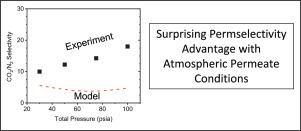Overlooked glassy polymer attributes illustrated by asymmetric polyimide hollow fibers
IF 4.7
Q1 ENGINEERING, CHEMICAL
引用次数: 1
Abstract
Gas separation membranes based on glassy polymers often show complex responses to feed compositions, membrane morphologies, and operating conditions. The well-known dual mode sorption and transport models are discussed here as tools to assess plasticization and competition effects in asymmetric morphologies. A framework is illustrated based on these models using polyimide asymmetric hollow fibers. This framework can also be applied to emerging polymer families such as thermally rearranged (TR) and polymers of intrinsic microporosity (PIM), to identify opportunities connected to their innate glassy natures.

不对称聚酰亚胺中空纤维显示了被忽视的玻璃聚合物属性
基于玻璃状聚合物的气体分离膜通常对进料成分、膜形态和操作条件表现出复杂的响应。本文讨论了众所周知的双模式吸收和输运模型,作为评估不对称形态中塑化和竞争效应的工具。在这些模型的基础上,用聚酰亚胺不对称中空纤维构造了一个框架。该框架也可以应用于新兴聚合物家族,如热重排聚合物(TR)和固有微孔聚合物(PIM),以识别与其固有玻璃性质相关的机会。
本文章由计算机程序翻译,如有差异,请以英文原文为准。
求助全文
约1分钟内获得全文
求助全文

 求助内容:
求助内容: 应助结果提醒方式:
应助结果提醒方式:


